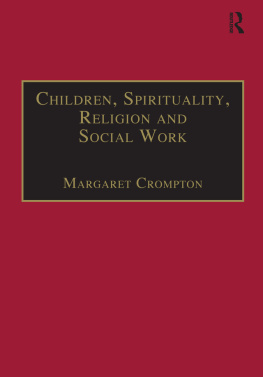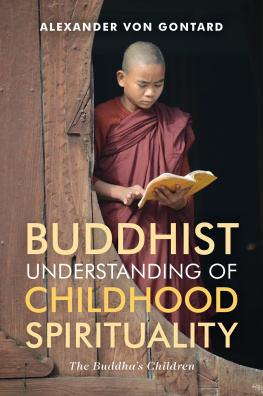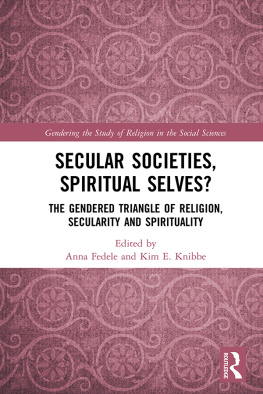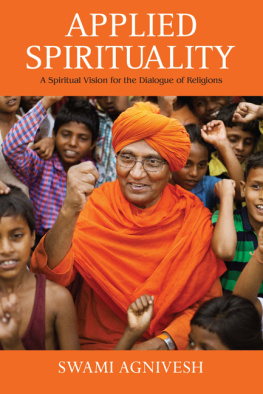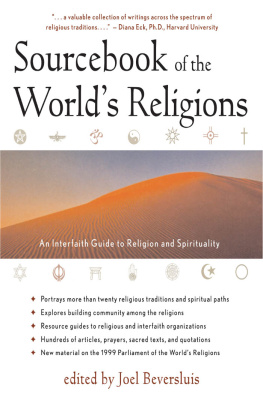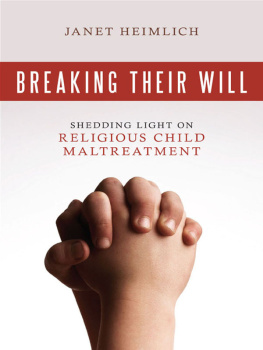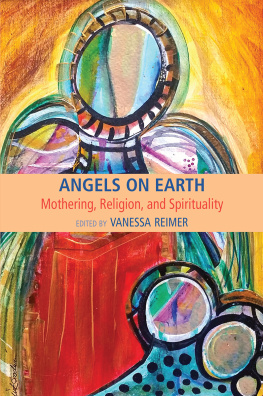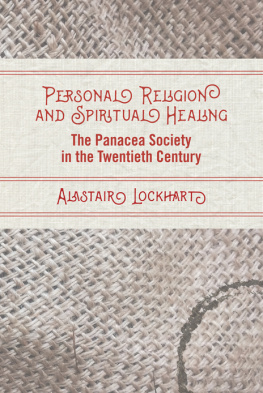First published 1998
by Ashgate Publishing
Published 2016
by Routledge
2 Park Square, Milton Park, Abingdon, Oxon OX14 4RN
711 Third Avenue, New York, NY 10017, USA
Routledge is an imprint of the Taylor & Francis Group, an informa business
Copyright Margaret Crompton 1998
All rights reserved. No part of this book may be reprinted or reproduced or utilised in any form or by any electronic, mechanical, or other means, now known or hereafter invented, including photocopying and recording, or in any information storage or retrieval system, without permission in writing from the publishers.
Notice:
Product or corporate names may be trademarks or registered trademarks, and are used only for identification and explanation without intent to infringe.
British Library Cataloguing in Publication Data
Crompton, Margaret, 1941
Children, spirituality, religion and social work
1. Children - Religious life 2. Children - Services for
3. Children - Counseling of
I. Title
362.7
Library of Congress Catalog Card Number : 98-70340
ISBN 13: 978-1-85742-377-8 (pbk)
I thank all the people whose contributions enabled me to research and write this text.
In order to relate this discussion of spirituality and religion firmly to everyday life and practice, I met practitioners in a number of settings (including both local authority and voluntary agencies), who generously gave time and shared ideas and memories. The interest they showed in the topics gave me encouragement essential to completing what proved to be a huge, and often exhausting, task. Except for Martin House (see ), agencies are not identified, to protect confidentiality.
The Central Council for Education and Training in Social Work generously gave permission for me to develop ideas and to quote from papers which first appeared in the training; pack Children, Spirituality and Religion (Crompton 1996).
The following publishers gave free permission for substantial quotations from the following publications: Chapman and Hall for Hill (1994), the Children's Rights Office (CRO) for CRDU (1994), Routledge for Sinason (1994), and The Children's Society for Bradford (1995).
Valerie Sinason and Janet West commented on drafts of and gave permission for quotations from their publications (Sinason 1994; West, J. 1996).
Jo Gooderham gave me the opportunity to pursue study of the topics which are discussed below and provided perfect editorial support, always answering my fussy questions quickly, and reducing anxiety with calm, sensible advice. Kate Trew continued this editorial support with efficiency and sensitivity.
John Crompton advised, chauffered, corrected, discussed, read, shared adventures and supported me with patient love.
Children of spirit
Ruby Bridges was 6 when she braved hostile mobs, the only black child to claim her right to attend an integrated school in New Orleans (see ). She responded to hatred, threats and insults with cheerfulness, determination and compassionate charity, forgiving her persecutors in accordance with the example of her religious and spiritual leader, Jesus, because: 'When he was dying, he asked God to forgive the people who were killing him' (quoted in Coles 1984, p.xiii).
For Ruby, religion and spirituality were the unquestioned fundamentals of everyday life. As a Christian, her spirituality was expressed through religious forms of worship and language. However, spirituality is not necessarily associated with religion. Neither is it the prerogative of children with a command of verbal communication. Edward (aged 2) was described as 'oozing spirituality', exhibiting 'all the capacities and predispositions of an individual who has an awareness of the spiritual dimension of ... life', and able to experience 'ecstasy, totally absorbed in and drawn towards realities outside himself (McClure 1996, p.9; see ).
Such delight may be submerged by busy-ness and pressures, yet can be nurtured in apparently inimical circumstances. Joanna (aged 10) found spiritual refreshment in an imaginary garden, contrasting with her gloomy, noisy home life, where she could think about God and seek a better life (Nye 1996, 2/16 and 17; see ).
).
Not all assaults are physical. A nurse fed pork to a Muslim baby because it was too much trouble to order permitted food (see ).
Spirituality, whether or not expressed through religious belief and observance, can be respected and nurtured in every setting. It is integral to the whole child and to the whole of everyday, every-minute living and dying. 'Maria' died after a life of physical weakness and suffering due to incurable illness which could have been identified in utero. However, as she told hospice staff who loved her and admired her great spirit, she was opposed to termination of pregnancy on the ground of genetic risk for, if her mother had made such a choice, Maria would have lost the chance of life, which she relished (see ).
These and many other children may be found in the following pages, illustrating the importance of really attending to the whole person.
Background
An Indian proverb describes the individual as 'a house with four rooms, a physical, a mental, an emotional and a spiritual', advising that 'unless we go into every room every day, even if only to keep it aired, we are not a complete person' (Godden 1989, p.13).
This proverb provided the title for a chapter exploring spiritual aspects of counselling in relation to children in an earlier book (Crompton 1992). Expecting to find little material, I was encouraged by the range of sources and ideas available in both professional literature and fiction which offered enlightenment about spiritual experiences of not only children but also practitioners. Brian Thorne (Director, Centre for Counselling Studies, University of East Anglia), for example, wrote of his recognition of 'a capacity to express tenderness both physically and spiritually', 'a tenderness that moves the soul while embracing (sometimes literally) the body; acknowledgement of his spiritual self enabled him to bring his whole self into counselling encounters (Mearns and Thorne 1988, p.37; see also Crompton 1992, p.114).
In 1964, Noel Timms (a social work lecturer, later professor) had identified that although 'perhaps in religious belief and practice ... a person's values are most clearly apparent ... the relationship between religion and casework has received little attention'. He proposed 'A new appraisal... based on the assumption of the importance and significance of religious belief and feeling in human beings' which should not 'be hidden away or dissolved by analysis' (cited in Moran 1968, p.94; see also Crompton 1992, p.114).
In 1992, it seemed that such an appraisal was still awaited, that the significance and importance of religious belief - and, I would add, spiritual experience and well-being - were still largely obscure. Brian Thome's acknowledgement of his spirituality had a confessional element, almost a 'coming out'.
Two important documents were published in the early 1990s but perhaps had limited distribution among social workers. The National Children's Bureau Taking Care pack noted the problems of theological language when associated with abuse which 'might have an effect on the child's spiritual life' (Armstrong 1991, p.18; see also Crompton 1992, pp.115-16). The National Youth Bureau published a survey on the spiritual development of young people which included a summary of the attitudes of youth workers: some, for example, believed spiritual development to be 'an integral part of youth work, quite independent of any particular form of religious belief or organized religion' (Garrett 1990, p.1; see also Crompton 1996, 4/6).

